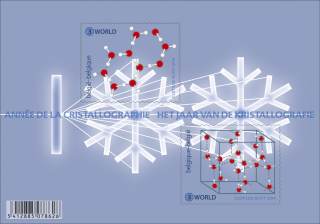
Belgian commemorative stamp issue
Crystallography? Literally the word means 'description of a crystal'. Crystals fascinate all of us by their colour, clarity and especially their symmetry. Early studies of crystals focused on the description of their external shape.
![[details of postage stamps]](https://www.iycr2014.org/__data/assets/image/0011/98390/belgium-2014-1.jpg) More than four hundred years ago, more precisely on 1 January 1611, Johannes Kepler became interested in falling and swirling snowflakes. He came quickly to the conclusion that snowflakes always possess hexagonal symmetry. But why was this always so? Kepler assumed that regular external structure resulted from a regular packing of spheres in the growth of snowflakes. So Kepler was the first scientist to describe the link between external and internal structure, despite having no real evidence. At that time it was impossible to look inside a snowflake.
More than four hundred years ago, more precisely on 1 January 1611, Johannes Kepler became interested in falling and swirling snowflakes. He came quickly to the conclusion that snowflakes always possess hexagonal symmetry. But why was this always so? Kepler assumed that regular external structure resulted from a regular packing of spheres in the growth of snowflakes. So Kepler was the first scientist to describe the link between external and internal structure, despite having no real evidence. At that time it was impossible to look inside a snowflake.
In 1895 Wilhelm Röntgen discovered rays that were later called Roentgen or X-rays. A few years later in 1911, in Munich, Max von Laue and his collaborators conducted a revolutionary experiment: they placed a crystal in a beam of Roentgen rays and demonstrated that the beam was deflected in different directions. Modern crystallography comes directly from this experiment. A year later, in Cambridge, father and son William Henry and William Lawrence Bragg, established the relationship between the direction and intensity of the deflected beam and the internal structure of crystals. They showed that X-rays can be used to accurately determine the position of atoms in a crystal. In this way, they discovered for the first time the three-dimensional crystal structure of salt. For this discovery they received the Nobel Prize in 1915; von Laue also received the Nobel Prize, in 1914. Their contribution to the natural sciences is difficult to overestimate: the three-dimensional structure of a material determines its properties. Over the following decades more complex structures were discovered, from those of simple inorganic salts to those of DNA and protein complexes.
In 2014, 100 years after the pioneering work of von Laue and Bragg, father and son, the International Year of Crystallography is being celebrated. UNESCO and the IUCr (International Union of Crytallography) want to highlight the role of modern crystallography in our everyday lives. Research in crystallography supports the development of virtually all new materials, ranging from new medicines, toothpaste, chocolate, computer memory up to parts for cars and planes.
The Belgian post bpost issued on 9 June 2014, on the occasion of the International Year of Crystallography, two postage stamps and a leaflet entitled 'Les cristaux mis en lumière' (crystals in the limelight). For the first time these stamps have been printed on a semi-transparent adhesive base, to remind us of the clarity of many crystals. The project is the work of Clotilde Olyff and the scientific viewpoint was provided by Luc Van Meervelt. The accompanying leaflet illustrates snow crystals and the principle of diffraction. The two stamps show in detail the arrangement of water molecules in two variants of an ice crystal.
A matching set of stamps and show card was published on 30 May 2014 in the joint issue with the Slovenian Post Office.
![[leaflet showing mounted stamps]](https://www.iycr2014.org/__data/assets/image/0005/86414/11-CRISTALLOGRAPHIE-feuillet.jpg)
Date of issue: June 9, 2014
Design of Stamp and Souvenir Sheet: Clothilde Olyff
| Contact for scientific information | Luc Van Meervelt luc.vanmeervelt@chem.kuleuven.be |
| URL for general philatelic information, sales etc. | http://www.bpost.be/site/fr/residential/stamps/philately/stamps/2014/index.html |
| Category | postage stamps |


